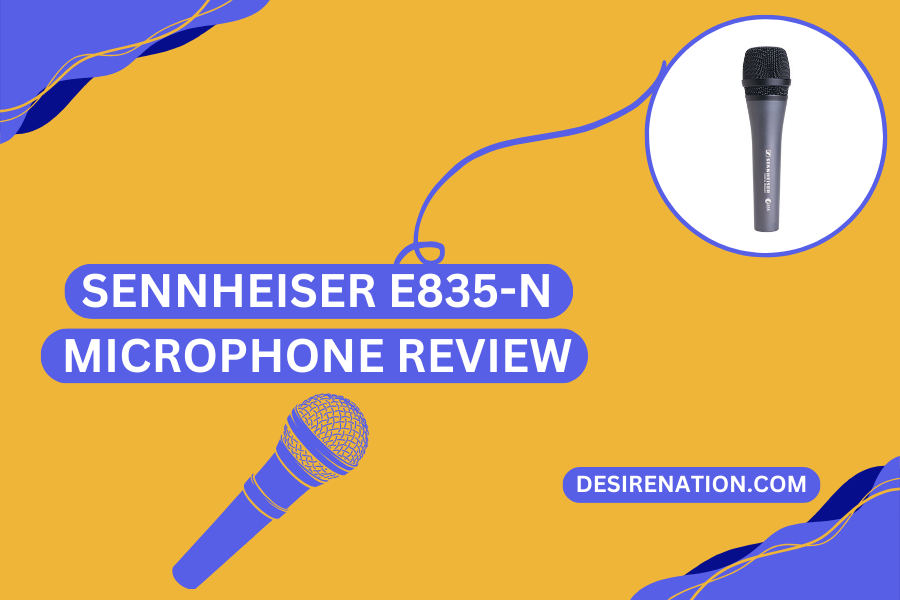The Sennheiser e835-N is a dynamic microphone renowned for its exceptional performance in live sound applications. In this comprehensive review, we’ll dive into the specifications, strengths, and considerations of this microphone, providing you with valuable insights for your audio endeavors.
Specifications
- Type: Dynamic
- Polar Pattern: Cardioid
- Frequency Response: 40 Hz – 16,000 Hz
- Sensitivity: 2.7 mV/Pa
- Impedance: 350 Ohms
- Weight: 330 grams
- Connector: XLR
Pros of the Sennheiser e835-N
- Exceptional Sound Quality: The e835-N delivers clear and natural sound reproduction, making it an excellent choice for vocals and instruments alike.
- Effective Feedback Rejection: Its cardioid polar pattern ensures focused sound capture from the front, reducing feedback from monitors.
- Durable Construction: Built to withstand the demands of live performances, the e835-N features a robust metal body.
- Affordable Excellence: It provides professional-grade performance at a relatively affordable price, offering great value for the investment.
- Low Handling Noise: The microphone effectively minimizes handling noise, allowing for clean and uninterrupted performances.
Cons of the Sennheiser e835-N
- Limited Frequency Range: While optimized for vocals, it may not capture the full range of some instruments.
- Weight Consideration: It is slightly heavier compared to some microphones in its category, which might be a consideration for some users.
Overall Rating
4.6/5
The Sennheiser e835-N stands out as a dynamic microphone that strikes an excellent balance between performance, durability, and affordability. Its clear sound reproduction and feedback rejection make it a reliable choice for live sound applications.
Similar Products
Shure SM58
- Type: Dynamic
- Polar Pattern: Cardioid
- Frequency Response: 50 Hz – 15,000 Hz
- Sensitivity: -54.5 dBV/Pa
- Impedance: 150 Ohms
- Weight: 298 grams
- Connector: XLR
Audio-Technica ATM510
- Type: Dynamic
- Polar Pattern: Cardioid
- Frequency Response: 90 Hz – 16,000 Hz
- Sensitivity: -55 dBV/Pa
- Impedance: 300 Ohms
- Weight: 258 grams
- Connector: XLR
Should I get a Sennheiser e835 mic with or without an on/off switch
Whether you should get a Sennheiser e835 microphone with or without an on/off switch depends on your specific needs and preferences. Here are some factors to consider:
- Convenience: A microphone with an on/off switch can be more convenient for quickly muting the audio when needed. If you anticipate situations where you may need to mute the microphone frequently, having a built-in switch can be beneficial.
- Live Performances: If you plan to use the microphone for live performances, having an on/off switch can be useful for managing sound during breaks or between songs. It allows you to easily cut off audio when not in use, preventing unintentional background noise.
- Recording: For studio recording or situations where you have more control over the recording environment, an on/off switch may be less critical. In these cases, you can control the microphone through other means, such as audio interfaces or recording software.
- Budget: Microphones with on/off switches may be slightly more expensive than their counterparts without switches. Consider your budget and whether the added convenience is worth the extra cost.
- Personal Preference: Some users prefer microphones without on/off switches to avoid the risk of accidentally muting the microphone during a performance or recording. Others find the convenience of a switch to be essential.
In conclusion, if you anticipate needing to mute the microphone frequently or value the convenience of quick on/off control, then choosing the Sennheiser e835 with an on/off switch may be a good option. However, if you prefer simplicity and have the ability to control the microphone through other means, then the version without a switch might be suitable for your needs.
Does Sennheiser e835 need phantom power?
No, the Sennheiser e835 does not require phantom power. The Sennheiser e835 is a dynamic microphone, and unlike condenser microphones, dynamic microphones do not rely on phantom power for their operation. Dynamic microphones generate an electrical signal through electromagnetic induction, and they are generally more robust and versatile in various recording situations. Phantom power is typically used to power condenser microphones, which have a different internal design that requires an external power source for proper functioning. Therefore, when using the Sennheiser e835, you do not need to provide phantom power for it to work.
How much gain does the Sennheiser e835 need
The amount of gain required for a Sennheiser e835 microphone depends on various factors such as the source sound level, the distance between the microphone and the sound source, and the specific audio equipment being used. The Sennheiser e835 is a dynamic cardioid microphone, and its sensitivity is designed to handle sound pressure levels typically encountered in live sound applications.
As a general guideline, dynamic microphones like the e835 usually require more gain compared to condenser microphones, but they are better at handling high sound pressure levels. It’s essential to set the gain appropriately to capture the desired audio without introducing too much noise or distortion.
In a live sound setting, the gain for the Sennheiser e835 can be adjusted using the preamp or mixer connected to the microphone. Experimenting with different gain settings while monitoring the audio output will help find the optimal level for your specific situation. Additionally, factors such as the type of sound source (e.g., vocals, instruments) and the acoustics of the environment will also influence the ideal gain setting.
How big is the Sennheiser e835?
Is the Sennheiser e835 a good microphone
Final Words
The Sennheiser e835-N microphone offers an impressive combination of professional-grade sound quality, durability, and affordability. Whether you’re a vocalist, instrumentalist, or sound engineer, this dynamic microphone is a reliable choice that will enhance your live performances.
FAQ
Q: Can I use the e835-N for studio recordings?
A: Yes, the e835-N can be used in studio settings, particularly for vocals and close-miking instruments.
Q: Is a pop filter necessary with the e835-N?
A: While the e835-N has built-in pop-filtering features, additional pop filters may be used for enhanced plosive reduction.
Q: Does the e835-N require phantom power?
A: No, the e835-N is a dynamic microphone and does not require phantom power to operate. Simply connect it to your audio interface or mixer, and you’re ready to go.
You Might Also Like These:












